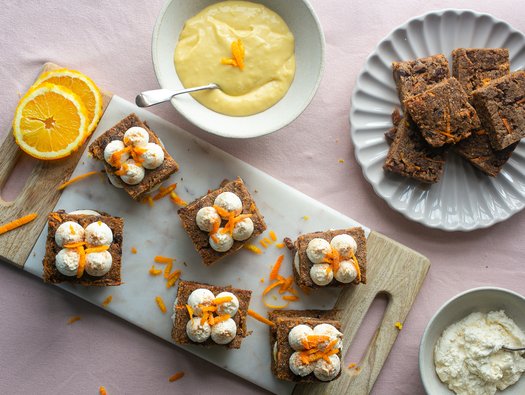Carrot cake from leftover bread

This cake makes delicious use of leftover bread for an indulgent, low potassium treat.

This cake makes delicious use of leftover bread for an indulgent, low potassium treat.
400g bread (white or wholemeal), torn
100g soft light brown sugar
1 egg
100g full fat yoghurt
50g vegetable oil
2 teaspoons ground cinnamon
1 teaspoon bicarbonate of soda
1 teaspoon vanilla extract
Zest of 1 orange
90g carrot, grated
90g raisins
1 egg yolk
1 tablespoon caster sugar
100g passion fruit juice
15g unsalted butter
1 tablespoon cornflour
100g double cream
100g mascarpone cheese, softened
25g icing sugar
1 teaspoon vanilla essence
½ teaspoon cinnamon
1 teaspoon thin slices of orange peel
Pre-heat the oven to 175°C / 145°C fan / gas mark 4 and grease and flour a rectangular baking tray 11” x 8.5”. Add the torn bread to a food processor and blitz to fine crumbs. Add the sugar, egg, yoghurt, oil, ground cinnamon, bicarbonate of soda and vanilla extract and blend until smooth. Pour into a mixing bowl and stir in the orange zest, carrot and raisins until evenly mixed. Put the cake mix into the baking tray and bake for 25-30 minutes, until a skewer comes out clean.
Passionfruit curd: Whisk the egg yolk and sugar together and set aside in a bowl. In a heavy-bottomed saucepan, gently heat the passion fruit juice and butter just until the butter has melted, then gradually stir in the cornflour making sure you mix continually so there are no lumps. Take the mixture off the heat and whisk a few tablespoons of it into the egg mixture in the bowl. Continue whisking, adding a few tablespoons of the mixture into the egg mixture at a time.
Once the two mixtures are fully combined, pour it back into the saucepan and return to a low to medium heat, stirring continually so that the eggs don’t curdle or scramble. Cook for 5-8 minutes until the curd has thickened. Remove from the heat and strain through a fine mesh sieve into a bowl. Cover with clingfilm directly on the surface of the curd and refrigerate for at least 2 hours before using.
When the cake is baked and the skewer comes out clean, remove from the oven and leave to cool for 10 minutes before transfering to a wire rack to continue cooling.
Mascarpone cream: In a mixing bowl, beat the mascarpone cheese and double cream until smooth and creamy. Gradually add the icing sugar and vanilla extract and continue beating until well combined.
Once the cake is cooled, cut into 20 squares. Pipe cream around edges of 10 squares of cake and fill the centres with a little curd. Place the remaining 10 squares on top and decorate with the remaining cream. Sprinkle with cinnamon and orange peel to finish. Let the cakes rest overnight in a cool place or even in the fridge, so the flavours develop.
The bread is the main source of carbohydrate in this recipe, and the value has been provided for those who have been trained in insulin adjustment.
This recipe is low in potassium, when following the quantities and serving sizes given, so is a suitable treat for those advised to reduce the potassium in their diet.
This recipe is high in phosphate, therefore, enjoy as an occasional treat, and if you have been prescribed a phosphate binder, take as directed.
This recipe is low in protein, therefore suitable occasional treat, if you have been advised to eat less protein.
It may be difficult to source passion fruit juice. Instead, consider mango or pineapple (these are lower in potassium than apple or orange juice).
Use gluten-free bread
This recipe is high in fat and contains a moderate amount of salt from the bicarbonate, and should be only be enjoyed occasionally, as part of a healthy balanced diet.
Once cooked and cooled, this recipe can be stored in an airtight container in the fridge for up to 3 days.
Living with kidney disease doesn’t mean missing out on all baked goods, even on a low-phosphate diet. Kidney Kitchen recommends some tips and tweaks to help make your bakes a little more kidney-friendly.
You can enjoy a wide variety of delicious and healthy food when you are living with kidney disease. All Kidney Kitchen recipes are analysed and approved by kidney dietitians. Search through our kidney-friendly recipes or filter them by category below.
Just like the classic, this red velvet cake is a deep rich red with vanilla and cocoa flavour. Topped with a tasty vegan cream cheese frosting, it’s perfect for any special occasion.
By giving us your email address, you're giving us permission to send you the latest news from Kidney Care UK. Further information about how we protect and use your personal data is available in our Privacy policy. If you would like to change the way we communicate with you at any time please email [email protected]. You can unsubscribe at any time by using the link at the bottom of every email we send.